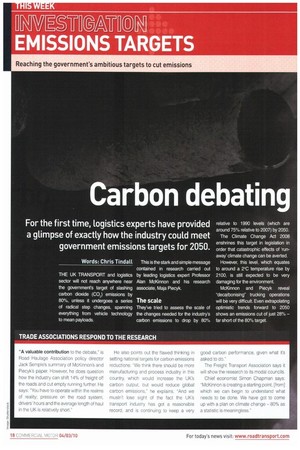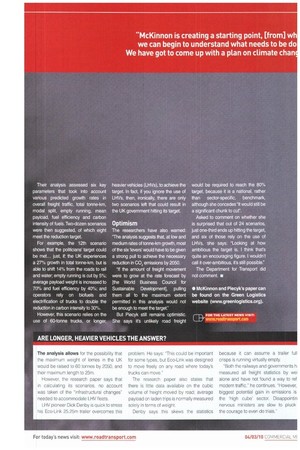Carbon debating
Page 18

Page 19

If you've noticed an error in this article please click here to report it so we can fix it.
For the first time, logistics experts have provided a glimpse of exactly how the industry could meet government emissions targets for 2050.
Words: Chris Tindall
THE UK TRANSPORT and logistics sector will not reach anywhere near the government's target of slashing carbon dioxide (CO2) emissions by 80%. unless it undergoes a series of radical step changes. spanning everything from vehicle technology to mean payloads
This is the stark and simple message contained in research carried out by leading logistics expert Professor Alan McKinnon and his research associate, Maia Piecyk.
The scale
They've tried to assess the scale of the changes needed for the industry's carbon emissions to drop by 80°. relative to 1990 levels (which are around 75% relative to 2007) by 2050 The Climate Change Act 2008 enshrines this target in legislation in order that catastrophic effects of 'runaway' climate change can be averted However, this level, which equates to around a 2"C temperature rise by 2100, is still expected to be very damaging for the environment.
McKinnon and Piecyk reveal decarbonising" trucking operations will be very difficult. Even extrapolating optimistic trends forward to 2050 shows an emissions cut of just 28°. far short of the 80% target. Their analysis assessed six key parameters that took into account various predicted growth rates in overall freight traffic, total tonne-km, modal split, empty running, mean payload, fuel efficiency and carbon intensity of fuels. Two-dozen scenarios were then suggested, of which eight meet the reduction target.
For example. the 12th scenario shows that the politicians target could be met... just, it the UK experiences a 27% growth in total tonne-km, but is able to shift 14% from the roads to rail and water; empty running is cut by 5%; average payload weight is increased to 70% and fuel efficiency by 40%: and operators rely on biotuels and electrification of trucks to double the reduction in carbon intensity to 30%.
However, this scenario relies on the use of 60-tonne trucks, or longer, heavier vehicles (LHVs), to achieve the target In fact, if you ignore the use of LHVs, then, ironically, there are only two scenarios left that could result in the UK government hitting its target.
Optimism The researchers have also warned: 'The analysis suggests that, at low and medium rates of tonne-km growth, most of the six 'levers' would have to be given a strong pull to achieve the necessary reduction in CO2 emissions by 2050.
'If the amount of freight movement were to grow at the rate forecast by [the World Business Council for Sustainable Development], pulling them all to the maximum extent permitted in this analysis would not be enough to meet the target' But Piecyk still remains optimistic She says it's unlikely road freight would be required to reach the 80°./0 target, because it is a national. rather than sector-specific, benchmark, although she concedes "it would still be a significant chunk to cut".
Asked to comment on whether she is surprised that out of 24 scenarios, just one-third ends up hitting the target, and six of those rely on the use of LHV,s, she says. "Looking at how ambitious the target is. I think that's quite an encouraging figure. I wouldn't call it over-ambitious, its still possible."
The Department for Transport did not comment. •
• McKinnon and Piecyk's paper can be found on the Green Logistics website (www.g reen log istics.org).
































































































































